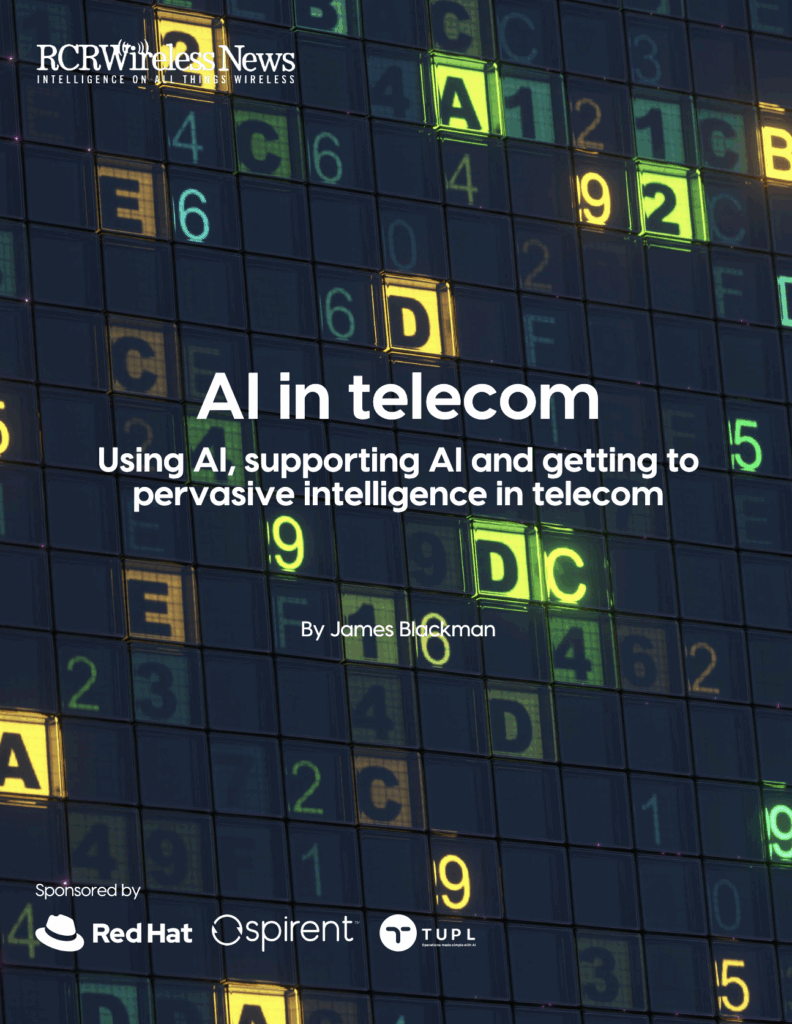For telcos, the surest AI wins come in their operational heartlands – streamlining customer care, enhancing enterprise services, and turning network data into actionable insights.
System support – AI in telecom has primarily advanced in low-risk OSS/BSS, focusing on customer care and network optimization.
Operator models – Verizon segments AI in ‘three buckets’, starting with service support and personalisation (see later for the third bucket).
Pattern-matching – new AI deployments go beyond rule-based analytics by correlating data streams to improve transparency and control.
Note: This article is continued from a previous entry, available here, and is taken from a longer editorial report, which is free to download – and available here, or by clicking on the image at the bottom. An attendant webinar on the same topic is available to watch on-demand here.
But just to back up first – to scan the horizon again, and pick up a new rider (or two, or more): AI, of whatever type, takes root in telecom in operational and business support systems (OSS and BSS) first – always. It starts with functions and applications that are rich in data, low in risk, and quick to reward. To date, AI deployments have focused on automating customer care, streamlining service delivery, and improving billing processes.
“It starts with the lowest hanging fruit,” remarks Nelson Englert-Yang, industry analyst at ABI Research. “Which has been these OSS/BSS implementations – especially for care and support. I have a list of about a hundred use cases – and interesting ones about things like network design and expansion, drawing on machine learning and digital twins to calculate where to lay last-mile infrastructure. But OSS/BSS is where they are finding the quickest value.”
Robert Curran, consulting analyst at Appledore Research, says the same – that AI has been most effective where it is “easy to contain”, and where it makes use of well-understood predictive machine learning algorithms – developed “like a roll-through from all the big data stuff” that has drawn the focus of digital change processes for a decade, at least. “Ninety-five percent of the time when telcos talk about AI [usage], they are talking about machine learning.”
He goes on: “Customer data is an obvious place to look: demographic patterns, customer segmentation; about who’s using what, and what for, and movement in the network – and from there, how to determine a more efficient or valuable product or offer, or just a way to channel people to the right support. Plenty of companies are doing that. It is a whole market in itself – from the chatbot side, through to marketing and segmentation and data analytics.”
There are three “buckets” for AI at Verizon, says Verizon – like for most telcos, by extension. “Each is further along in the company than the next as far as maturity goes,” explains Steve Szabo, vice president for technology enablement in the technology solutions division at Verizon Business. Generally, these cover quite-new AI advances in quite-old ML practices, mostly covering internal functions like customer care and network maintenance.
The first of these “buckets” bundles back-end AI to help with customer support functions – “the stuff you’re used to hearing about in this space,” says Szabo. The goal, as always with automation, is to improve operational efficiencies; the context, as always with service, is to reduce “friction” alongside – in this case, by placating disgruntled customers, calling in because they have issues with networks, systems, devices, applications, and so on.
“Any friction we can take out of the system is helpful. And these types of things are really important,” he says. The big change, recent and ongoing, is to avail the much-maligned interactive voice response (IVR) system in customer support with new brain power – so calls are not just directed to the right department, but to the right person within the department. “What we’ve been able to do [with AI] is to auto-route their problem to the rep with the most experience.”
He adds: “It is matchmaking, if you will – between a service issue and a service rep.” The AI crawls a developing database of service calls, along with the source of the problem and the author of the solution. “It is not secret stuff; but it has helped tremendously,” says Szabo. Its second focus (‘bucket’) is to personalize its product suite to meet demand – mutating into expectation – from enterprises, increasingly born-digital, for control of their digital services.
“They expect low-touch AI management and personalized products, so they don’t have to call up every time they want to make checks and changes,” he explains. Verizon has been embedding AI into its as-a-service portals so enterprises can troubleshoot the performance of their networks, devices, and apps to bring some two-way dynamism to service management and security, as well as to draw on features in the latest ‘standalone’ version of 5G (5G SA).
This is where “lots of time” has gone over the last 24 months, he says. “We are leveling-up our infrastructure to provide these tools and capabilities and insights, whether through APIs, where they can pull [the network] into their ecosystem, or through our own configuration tools, where they can get insights and control over their devices and networks. Because they don’t just want us just to proactively let them know; they want to see it for themselves.
He adds: “They want complete transparency, and AI lets us give them that.” He has an example about this AI logic around a data spike in the network. The firm is offering “real-time rating and usage with AI,” where an AI algorithm prompts actions in response to ML traffic alarms. “If a device goes rogue, and pings the network and racks up a bill, then maybe it’s been hacked, or maybe it’s on the wrong plan. Now they can evaluate it, right away.”
Previously, they would have been none-the-wiser until they got their bill. “It is early-stage AI insofar as you can take a lot of information, and deliver visibility and insights [about it],” he responds, when asked to grade it as an AI exercise. “It is not a one-for-one,” he says, as if its value is more profound, and scalable. In the end, it is the same kind of pattern, as with customer support – where AI sorts data, renders insights, and makes solutions easier to access.
It is different from just rule-based big data analytics, which has underpinned most service management platforms. “It correlates [responses across] a variety of data sets – network usage and performance, location management, cyber security and threats – to identify potential issues. The network is built, and the first step is to proactively get tools and insights into the hands of customers – to correlate data as AI,” says Szabo. Really, it’s statistical pattern matching.
This article is continued here.


